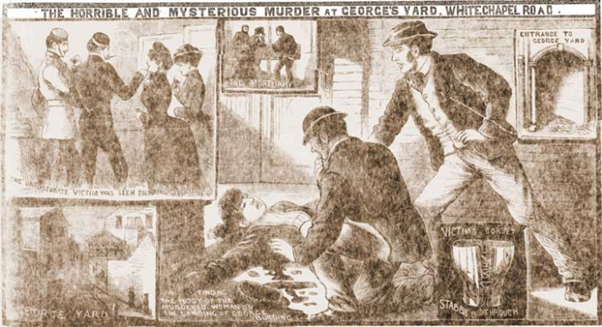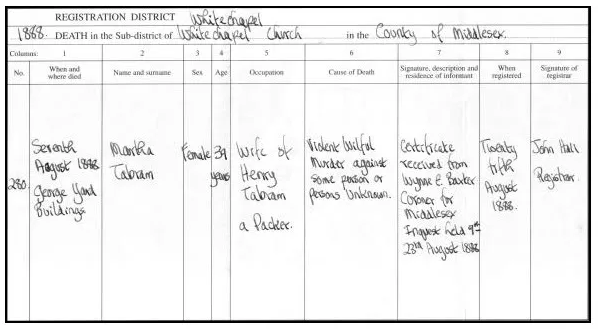Many people have asked me why I didn’t include Martha Tabram in my exploration of the lives of the women killed by Jack the Ripper. Martha is not considered one of the Canonical Five victims. However, I thought I’d briefly tell her story today, so buckle up... #thefivewomen
Martha died on the 7th of Aug, 1888, several weeks before Polly Nichols was killed. Her body was found on the landing of George Yard Buildings, off Wentworth street in Whitechapel. She’d been stabbed multiple times. That’s all I& #39;m going to say about her actual murder.
Martha’s life experience bears elements of each woman’s story in The Five; she was separated from her husband, she drank heavily, she took up with another partner after her marriage broke down and she spent time in lodging houses and the workhouse.
She was born on the 10th of Mary 1849 as Martha White in Southwark, the daughter of Charles White, a warehouse worker and his wife Elizabeth Dowsett. She was the youngest of 5 children. At the age of 16, her parents’ marriage fell apart and her mother and father separated.
6 months later, in 1865, her father died. He had been living by himself and suffering from recurrent diarrhoea. Too sick to work, one night he collapsed. I& #39;ve not discovered what happened to Martha’s mother, but it might be supposed she was living with one of her elder children.
Like many working class women, Martha lived with her future husband, Henry Tabram prior to their actual marriage on Christmas Day, 1869. Christmas weddings were a working class tradition, as marriage services were reduced or free and it was one of the few days people had off work
Henry worked as a foreman packer in a furniture warehouse, which meant his income was slightly better than that of her father’s. For a time, they lived on Pleasant Place, in Lambeth.
She bore two sons, Frederick in 1871 and Charles in 1872. It is likely there were more pregnancies, but in 1888, these two sons were the only surviving children of the marriage.
Much like Polly Nichols’ marriage, Martha and Henry’s marriage was not a good one. He claimed she drank too much and they split on account of this. It’s important to remember that her husband said this posthumously about her, and she couldn’t give her side of events.
What is known is that she ‘had a warrant taken out on him and had him locked up’. Some sources suggest it was because he refused to pay her maintenance of 12 shillings (quite a good separation maintenance). Perhaps it was on account of violence too?
Like Kate Eddowes, Martha took her boys with her. The large maintenance was probably paid on their account. When she moved in with a new partner, Henry Turner, he cut it to 2 s/6d. According to the law he didn’t have to pay her anything if she was living with another man.
Martha and Henry Turner lived together for roughly 10 years, and apparently, he helped look after her boys. He was a carpenter, but by 1888, he’d lost his job and the two were working as street hawkers selling menthol cones, needles and pins.
They had their differences, as Martha liked to drink – though interestingly, some evidence counters the story that she was an incorrigible drunk – the coroner suggested her liver was healthy and her landlady said she might have a drink followed by tea.
Like the other five women, everyone who has ever written about Martha has assumed she was a ‘prostitute’, when both Henry Turner and Henry Tabram both deny this. ‘Prostitute’ is not cited on her death certificate for ‘Occupation’.
This may be a case of guilt by association as the woman she spent her last evening with, Pearly Poll describes herself as ‘an unfortunate’. Self-identification as ‘a prostitute’ was the legal means by which ‘a prostitute’ was identified. Pearly Poll doesn’t describe Martha as one
As with all the victims, there’s a real investment in describing Martha as & #39;a prostitute& #39;. The opening line of her Wikipedia entry sums her up as ‘an English prostitute’
Pearly Poll & Martha were out drinking in pubs with two soldiers on the night she was killed. They coupled off and went in opposite directions. At the time, Martha had split up with Henry Turner. Who says she wasn’t looking for sex or a relationship, or payment for a sexual act?
We’ll never know and it really doesn’t matter. What matters is that she was killed, and the way we seem to sum up her life is to write off 39 years of life experience by giving her a label which was considered pejorative.
I’ve not done a fraction of the research on Martha that I have on the other five women, but I wanted to introduce you to her. I also wanted to draw attention to the problem of accepting historical ‘legend’ without questioning it.
There’s a lot more to Martha’s story than this, because there was a lot more to her identity than just her death.
If you are interested in learning about the lives (not the deaths) of the Canonical Five victims of Jack the Ripper, I just happen to have written a book... https://www.amazon.co.uk/Five-Untold-Lives-Killed-Ripper/dp/1784162345/ref=tmm_pap_swatch_0?_encoding=UTF8&qid=&sr=">https://www.amazon.co.uk/Five-Unto... https://www.waterstones.com/book/the-five/hallie-rubenhold//9781784162344?awc=3787_1586181164_917da14b44a19661091c26f91de64283&utm_source=259955&utm_medium=affiliate&utm_campaign=Genie+Shopping">https://www.waterstones.com/book/the-...

 Read on Twitter
Read on Twitter




